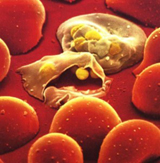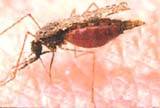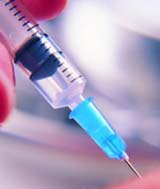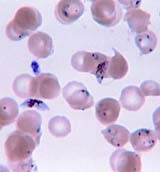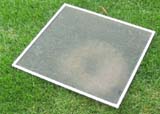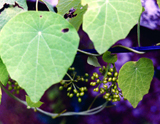Specific diseases
Malarial fever and its Āyurvedic management
Editor’s note
It is interesting to see how modern medicine is an infant science. Centuries, even milleniums ago when there were no modern gadgets, illnesses were being treated systematically, clearly and with discrimination. The additional information brought by microscopes and petridishes helps the process; one can detect the malarial parasite in the blood. But sometimes one can't. Then this Āyurvedic diagnosis may help...
In the Āyurvedic concept, malaria is considered viṣama jvara. Viṣama jvara means irregular in every aspect. Vagbhatt has clarified that the viṣama jvara starts irregularly and its process is also irregular. Vitiated doṣas in this type of fever do not have enough strength like other types of fevers. They get located in the rasa dhātu, attacking the body as and when they like. Hence, even if the fever subsides, the patient feels exhausted, heavy and lethargic. This feature of the fever is known as muktaanubandhitvam.
Pathophysiology:
Vitiation of doṣas
With vāta predominance
Sthānasaṁśraya (localisation) in different tissues
Viṣama jvara
Types of viṣama jvara
| Doṣas site | Types of viṣama jvara | Fever occurs on |
| Rasa | Santata | 8th, 10th, 12th day and continues |
| Rakta | Satata | Twice a day |
| Māṁsa | Anyedyuśka | Once every day |
| Meda | Tritiyaka | Alternate days |
| Asthi / majjā | Caturthaka | Every 4th day |
Āyurvedic aetiology
If a person suffering from fever starts exercising and consumes food substances like pudding, curd or meat and if he takes naps during daytime or consumes food even after indigestion, he then starts suffering from viṣama jvara.
Manifestation of malaria
Malaria is an infectious disease caused by a parasitic protozoa of the genus Plasmodium within the red blood cells. It is characterised by episodes of chills, fever and sweating, and by anaemia and enlargement of the spleen. It is transmitted by the female Anopheles mosquito which is mainly confined to tropical and sub-tropical areas.
Incidence
Malaria is found in many tropical countries. The disease kills about a million children in Africa alone each year. In collaboration with WHO, India launched the National Malaria Eradication Programme in 1958. However, WHO-controlled programmes have made little progress because mosquitoes have developed resistance to insecticides, and in some regions the parasites have also become resistant to certain anti-malarial drugs.
Causes of malaria
Malaria is caused by one of four protozoan species of the genus Plasmodium: They are:
1. P. falciparum2. Vivax
3. P. ovale
4. P. Malariae
The infecting protozoa can be any of these four species of the Plasmodium genus, which spend some part of their life cycle in the red blood cells of humans and some in Anopheles mosquitoes.
Female Anopheles mosquitoes transmit the parasites by first ingesting them from an infected person’s blood and then injecting them into a healthy person.
Symptoms of malaria
• Fever• Shaking chills
• Headache
• Muscle aches
• Tiredness
• Nausea
• Vomiting
Malaria symptoms may appear and disappear in phases and at various time- frames. Symptoms occur at least 7 to 9 days after being bitten by an infected mosquito.
Life cycle of the Plasmodium
The malaria parasite has a complex, multi-stage life cycle occurring within two living beings — the vector mosquitoes and the vertebrate hosts. The survival and development of the parasite within the invertebrate and vertebrate hosts, in intra-cellular and extra-cellular environments, is made possible by a toolkit of more than 5,000 genes and their specialised proteins that help the parasite to invade and grow within multiple cell types and to evade host immune responses. The parasite passes through several stages of development such as the sporozoites (Gr. sporos = seeds; the infectious form injected by the mosquito), merozoites (Gr. meros = piece; the stage invading the erythrocytes), trophozoites (Gr. trophes = nourishment; the form multiplying in erythrocytes), and gametocytes (sexual stages) and all these stages have their own unique shapes and structures and protein complements. The surface proteins and metabolic pathways keep changing during these different stages, helping the parasite to evade the immune clearance and also creating problems for the development of drugs and vaccines.
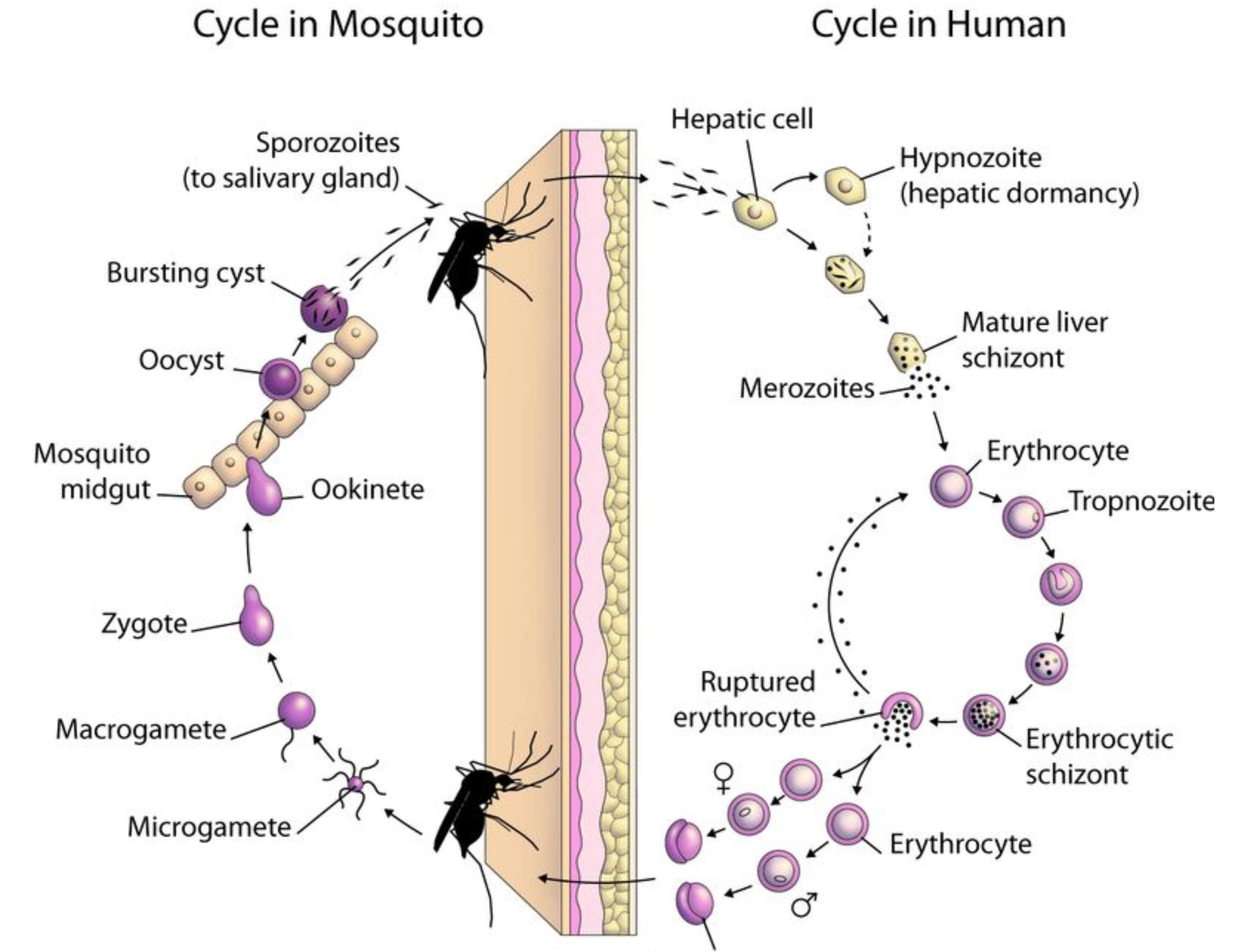
Types of malaria
Three types of malarial fever may be classified, depending on the symptoms or the parasite that causes the fever. They are:
1. Tertian fever2. Quartarn fever
3. Malignant fever
Tertian fever
The attack occurs on alternate days.
Quartarn fever
The attack occurs after an interval of two days, i.e. if first attack of fever occurs on the first day another attack will occur on the 4th day then on the 7th day and the 9th day and so on.
Malignant fever
This is the most severe and alarming type of malarial fever.
Prevention of malaria
Methods used to prevent the spread of disease and to protect individuals include mosquito eradication and prevention of mosquito bites.
The continued existence of malaria in an area requires a combination of high human population density, high mosquito population density and high rates of trans-mission from humans to mosquitoes and from mosquitoes to humans. If any of these is lowered sufficiently, the parasite will sooner or later disappear from that area.
• Draining of wetland breeding grounds and better sanitation.
• Elimination at larva stages, by filling up or applying oil to places with standing water.
• Indoor residual spraying:
Indoor residual spraying (IRS) is the practice of spraying insecticides (DDT, permethrin, deltamethrin) on the interior walls of homes in malaria affected areas. Many mosquito species rest on a nearby surface while digesting their blood meal from a human being, so if the walls of dwellings have been coated with insecticides, the resting mosquitoes will be killed before they can bite another victim and transfer the malaria parasite.
• Avoiding mosquito bites:
• Long-sleeve shirts and trousers should be worn when outside the house, especially at night when the Anopheles mosquitoes bite. Repellent creams and sprays can be used. Screened windows, the use of a mosquito net and coils also reduce the risk.
• Use of nima leaves or guggulu dhūpa for mosquito prevention.
Āyurvedic management of malaria
Āyurvedic drugs:
• Śambuka bhasma 120 - 720 mg bid with tulsi juice.
• Tribhuvana kirti rasa 1- 2 tabs bid with ginger juice and honey.
• Lakṣmī nārāyaṇa rasa 120 - 250 mg bid with ginger juice and honey.
• Malaria vaṭ ī 2- 4 tabs three times daily with milk or water.
• Amṛtāriṣṭa 20 ml bid with equal quantity of water after meals.
• Mahtāsudarśana ghana vaṭ ī 2 tabs and Amrita ghana vaṭ ī 1 tab three times a day with milk or warm water, recommended for 1 week.
In the treatment of viṣama jvara (malarial fever) a few decoctions are suggested by acāryas. The five types of these decoctions of drugs are enumerated below:
1. Kāliṅga (kūṭaja), leaf of pāṭola and kaṭūka rohinī (kūṭakī).
2. Pātola, sarivā, mustā, patha and kaṭuka rohinī.
3. Nimba, pāṭola, triphalā, māṛdvikā (drākṣā), mustā and vatsaka (kūṭaja).
4. Cirayatā, guḍuci, candana and śunṭhi.
5. Guḍuci, amlā and mustā.
Āyurvedic remedies for liver complaints
Generally given during malarial fever, the following herbal remedies can be beneficial and applied in the treatment as the liver is affected by the malarial parasite and the hepatomegaly or spleenomegaly is that of malaria. They are:
• Bhūmi’āmalā juice
• Aloe vera juice
• Kumāryāsava and lauhāsava each 20 ml thrice a day with equal quantity of water.
Āyurvedic diet for malaria
• A diet of raw or well-boiled fruits and vegetables to allow cleansing of the liver so that it can heal.
• Avoid spicy food and any foodstuff or liquid that cause considerable acidity when digested.
Some herbal and home remedies for the treatment of malaria
• Ciraytā helps in lowering the temperature. An infusion of the herb prepared by immersing 15 grams of ciraytā in 250 ml. of hot water with aromatics like clove and cinnamon (dālcīni) should be given in doses of 15-30 ml.
• Aluma is also useful against malaria. Firstly, take a small amount of aluma and then roast it over a hot plate and powder it. Half a teaspoon of this powder should be taken about four hours before the expected attack and a half teaspoon every two hours after that.
• The leaves of the holy basil (tulasi) are also considered beneficial in the prevention of malaria. The juice of about 11 leaves of tulsi mixed with the powder of 3 black peppercorns can be taken beneficially during the cold stage of the malaria fever.
Although malaria is an unpreventable misfortune, Āurvedic philosophy can help in healing the liver and fighting against the spread of the parasites and against further infection.
Bibliography
1. Golwalla, A.F. Medicine for students ; 17th edition. Mumbai; Churchgate, chapter 9.
2. Harrison, T. R. Harrison’s principles of internal medicines. McGraw-Hill, 16th edition, part 6, section 18.
3. Krishnanand ji, Shri. Rasa tantra sara evam Siddh yoga samgraha.Ajmer; Krishna Gopal Ayurveda Bhavan, 16th edition.
4. Mohan, H. Textbook of pathology. Jaypee brothers, 5th edition, chapter 7.
5. Pandey, K., Chaturvedi, G. Caraka chikitsā 3, Caraka saṁhitā. Chaukhambha Bharti Academy, 2003.
6. Pandey, K., Chaturvedi, G. Caraka nidāna 1, Caraka Caraka saṁhitā. Chaukhambha bharti Academy, 2003.
7. Pandey, K., Chaturvedi, G. Suśruta uttartantra 39.
8. Srikantha Murthy, K.R. Aṣṭāṅga Hṛdayam chikitsā 1 , Aṣṭāṅga Hṛdayam Volume 2. Varanasi; Krishnadas Academy, 3rd edition, 1998.
9. Srikantha Murthy, K.R. Aṣṭāṅga Hṛdayam nidāna 2, Aṣṭāṅga Hṛdayam, Volume 2. Varanasi; Krishanadas Academy.
10. Sudarshan Shastri, Shri. Mādhava nidāna 2. Chaukhambha Sanskrit bhawan, 3rd edition, 2004.
11. Weatherhall, D.J., Ledingham, G.G., Warrell, D.A. Oxford Textbook of Medicine. New York; Oxford University Press, 1983.
12. http://www.wikipedia.com
Dr. Riva Gupta is a scholar at the Postgraduate Department of Shareer Kriya, N.I.A, Jaipur; Smt. Archana Verma is Lecturer at the Department of Zoology, State Government College, Nakur, Saharanpur, U.P; Dr. Surendra Pal Singh Jaijania is Associate Professor at the Postgraduate College of Shareer Kriya, N.I.A., Jaipur.
Share with us (Comments, contributions, opinions)
When reproducing this feature, please credit NAMAH, and give the byline. Please send us cuttings.
